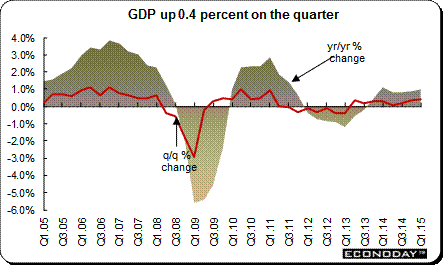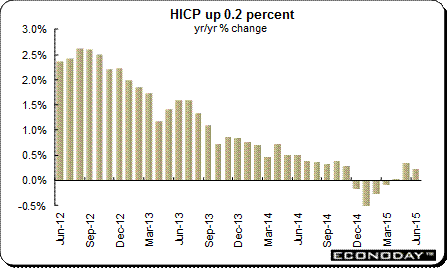
|
Gross domestic product — Growth weakened in 2012 as the sovereign debt crisis took its toll on growth. However, stabilization in the financial markets in 2012 did little to help economic growth. After contracting for six consecutive quarters, second quarter 2013 GDP was up 0.3 percent on the quarter but down 0.6 percent from the same quarter a year ago. However, third quarter GDP edged up only 0.1 percent. GDP continued to contract when compared with the same quarter a year ago, this time by 0.3 percent. GDP was up 0.2 percent in the fourth quarter and increased 0.5 percent from the same quarter a year ago. The Eurozone began 2014 with an increase of 0.2 percent on the quarter. On the year, GDP added 1.0 percent. The Eurozone added a revised 0.1 percent in the second quarter and was up 0.8 percent from a year ago. Third quarter GDP was up 0.2 percent on the quarter. On the year it added 0.8 percent as it did in the second quarter. Fourth quarter GDP was up 0.3 percent on the quarter and 0.9 percent from the same quarter a year ago.
First quarter GDP was up 0.4 percent on the quarter and 1.0 percent from the same quarter a year ago. Growth was hindered by a sharp slowdown in Germany where total output expanded a quarterly 0.3 percent following a 0.7 percent increase at the end of last year. However, France (0.6 percent after 0.0 percent) was surprisingly robust and Spain (0.9 percent after 0.7 percent) posted its strongest performance in more than seven years. Italy (0.3 percent after 0.0 percent) saw its first positive print since the third quarter of 2013. Among the smaller countries Cyprus (1.6 percent after declining 0.4 percent) finally pulled out of recession but Finland (minus 0.1 percent after minus 0.2 percent) saw a second successive quarter of falling output.
Industrial production — Most analysts readily acknowledge that the economy will not function to its fullest potential unless serious structural reforms are undertaken in the labor markets and the financial markets. For example, the industrial sector is the most dominant for the larger countries and the sector is embedded with labor rigidities that present a formidable challenge. Benefit cut backs are not politically expedient. It is difficult to fire employees or to cut back in times of weak growth without paying exorbitant severance and ongoing jobless benefits. These can be so lucrative that the incentive to find another job is non-existent.
Industrial production unexpectedly fell in May following a downwardly revised flat reading in April. Excluding construction output dropped 0.4 percent on the month, its second decline since February. Annual workday adjusted growth was 1.6 percent, up from 0.9 percent last time but only due to favorable base effects.
Regionally, the headline decline was dominated by the smaller member states and masked modest gains for most of the larger countries. France registered a 0.3 percent monthly advance, Italy was up 0.9 percent and Spain 0.4 percent. Germany was only flat but this followed a 0.8 percent increase in April. Elsewhere, Greece compounded April's 1.9 percent drop with a 5.1 percent slump, Ireland was down 6.9 percent and Estonia off 1.5 percent.
Inflation — As measured by the harmonized index of consumer prices, inflation soared above the ECB's two percent inflation target. However, prices declined as commodity prices weakened. The ECB's mandate as stated in the Maastricht Treaty that established the Bank is inflation control. This has been interpreted to mean that inflation control has a priority over encouraging growth. However, when the economy contracted, the ECB eased interest rates in conjunction with other central banks worldwide — but lagged both on the size and speed of the cuts. The HICP was above the ECB's 2 percent target from December 2010 to December 2012. However, since January 2013, the HICP dropped below the ECB's target because of weak growth and easing energy prices.
Annual inflation has been under 1.0 percent since October 2013, raising worries of deflation. The softer overall picture of prices is not what the ECB wants to hear and the fact that all member countries saw headline inflation well below target can only make matters more worrisome. However, the ECB was slow to acknowledge it may have a problem.
June's HICP equaled slipped to a reading of 0.2 percent on the year from May's 0.3 percent gain. Excluding food, alcohol, tobacco & energy, prices were running at a 0.8 percent annual rate down from 0.9 percent in May. The ECB may be disappointed that the upward trend in inflation has, at least temporarily, come to an end but deflation concerns are nothing like as significant as they were just a few months ago.
Unemployment — Unemployment fluctuated between 8.7 percent and 9 percent during 2004 and in 2005. However, it declined steadily from the summer of 2005 to spring of 2008. Unemployment reached a low of 7.2 percent in February and March of 2008. The unemployment rate increased to 11.7 percent in October 2012 where it remained for the last quarter of 2012 as the economy contracted under the pressures from the sovereign debt crisis. It remained about 12 percent during 2013. In 2014, the unemployment rate declined to 11.4 percent at year's end.
The decline continued into 2015 with January's unemployment rate at 11.3 percent. Unemployment inched downward to 11.2 percent in February and March and to 11.1 in April and May.
Merchandise trade — Trade plays an important role in European growth. German and Italian manufacturing sectors especially benefited from the weaker euro and it allowed them to sell their products overseas at reduced prices. Foreign trade had been a major contributor to revived economic growth, especially in Germany where consumer spending tends to lag. Despite the high value of the euro, trade continued to perform well for the most part until August 2008, when the financial crisis along with other effects on the real economy, virtually obliterated world trade. The trade balance was negative from November 2010 until September 2011 when it once again was positive. The balance has been in surplus since November 2011 but mostly on weak imports rather than export growth. Demand continues to be weak within the Eurozone.
|
|||||||
| Legal Notices | ©Copyright 1998-2024 Econoday, Inc. |
powered by
![[Econoday]](images/logo.gif)
![[Apple App Store]](/images/AppleAppStore.png) ![[Econoday on Kindle]](/images/kindle.jpg) 
|
||||||





